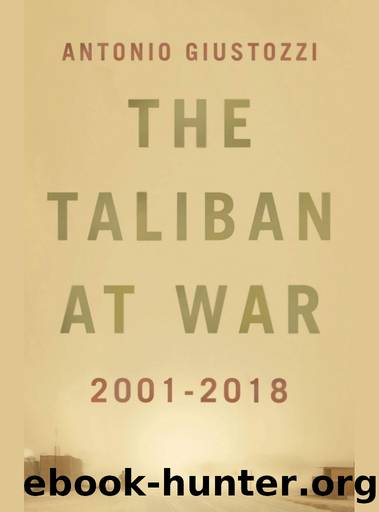The Taliban at War: 2001 - 2018 by Antonio Giustozzi

Author:Antonio Giustozzi [Giustozzi, Antonio]
Language: eng
Format: azw3
Tags: Nonfiction, War, History
ISBN: 9781787381322
Publisher: Oxford University Press
Published: 2019-06-26T23:00:00+00:00
6.7 The evolution of the combat forces
The expansion of the mobile forces
As discussed in Chapter 2, the first type of fully mobile forces developed by the Taliban were the loy mahazes. In principle, these mobile forces could be dispatched anywhere. In Chapter 3 we also discussed a different type of mobile force, the Delayez of the Miran Shah Shura, which like the loy mahazes, was established in 2005. Then in Chapter 4 we discussed a third type of mobile force, the dilghays of the Military Commission. All of these forces were better equipped than local Taliban groups, had machine guns in abundance (including heavy DSchK ones), and transport (mostly motorbikes).213 The Mashhad Military Commissionâs mobile forces was ensured by about 1,300 motorbikes as of 2015, according to Taliban sources.214 At about the same time the Peshawar Military Commission had 2,800 motorbikes, of which 1,000 were supplied by Iran.215
The commanders of groups and dilghays (twenty-five to thirty men) were selected by their superiors, usually from among the ranks of the group. The group and dilghay members could appeal to the superiors to replace an inadequate commander, including ones who could not deal effectively with village elders.216 There are three types of dilghays: âinfantryâ, sapper and âmotorisedâ. Motorised dilghays were better endowed with means of transport. Table 5 shows the strength of the dilghays or equivalent forces (the Miran Shah Shuraâs derabez) in 2015. Not all the âinfantryâ dilghays were mobile units; for example, only 45 per cent Quetta Shura Military Commission was mobile in 2015. By contrast, 70 per cent of the Mashhad Shura Military Commission was mobile as of 2015.217 The mobile dilghays were often mixed in ethnic and tribal composition.218
A fourth type of mobile force, the âmobile mahazâ, was established in early 2016. Four of them were established under different shuras, with up to 3,000 men each. These forces were similar to the motorised dilghays of the Peshawar Shura, which in fact merely relabelled them âmobile mahazâ.219
From 2005 the mobile forces expanded, despite some temporary setbacks. After the departure of Zakir in 2015, Akhtar Mohammad Mansur allowed the expansion of the Quetta Military Commissionâs forces, in part to counterbalance the power of the loy mahazes. The budget allocated to the Military Commission for the dilghays rose $50 million in 2014 to $65 million in 2015, and was expected to increase again in 2016.220
Since the dilghays offered better service conditions than the governor groups and most loy mahazes, they attracted recruits, to the extent that the Military Commissions were often able to reject volunteers.221
There were several rationales for establishing mobile forces. One was the ability to concentrate forces based on strategic decisions, as discussed in Chapter 2. The other was to control and stiffen the motivation of the local Taliban, who were not always keen to implement the orders and rules issued by the leadership. For example, one task that would fall on the mobile forces was the execution of members of the Afghan Security Forces, or their family members. Local Taliban were reluctant to do so because they feared a blood feud.
Download
This site does not store any files on its server. We only index and link to content provided by other sites. Please contact the content providers to delete copyright contents if any and email us, we'll remove relevant links or contents immediately.
| Africa | Americas |
| Arctic & Antarctica | Asia |
| Australia & Oceania | Europe |
| Middle East | Russia |
| United States | World |
| Ancient Civilizations | Military |
| Historical Study & Educational Resources |
The Light of Days by Judy Batalion(1062)
First Platoon: A Story of Modern War in the Age of Identity Dominance by Annie Jacobsen(902)
Stalin's War: A New History of World War II by Sean McMeekin(861)
The Pacific War 1941-1943 by James Holland(803)
Walk in My Combat Boots by James Patterson(763)
The American War in Afghanistan by Carter Malkasian(741)
Victory's Price (Star Wars) by Alexander Freed(734)
The Vietnam War: An Intimate History by Geoffrey C. Ward & Ken Burns(719)
Blood and Ruins: The Great Imperial War, 1931-1945 by Richard Overy(685)
Operation Pedestal by Max Hastings(681)
Concepts of Space by Jammer Max;(667)
Cold War (Alexander King Book 2) by Bradley Wright(660)
Extreme Fitness by Chris McNab(654)
The Madman Theory by Jim Sciutto(650)
Flying Tiger by Samson Jack(633)
World War II Infantry Fire Support Tactics by Gordon L. Rottman(611)
Pathfinders by AL-KHALILI JIM(611)
Panzerkrieg by Mike Syron(599)
Bismarck by Jean-Paul Bled(585)
